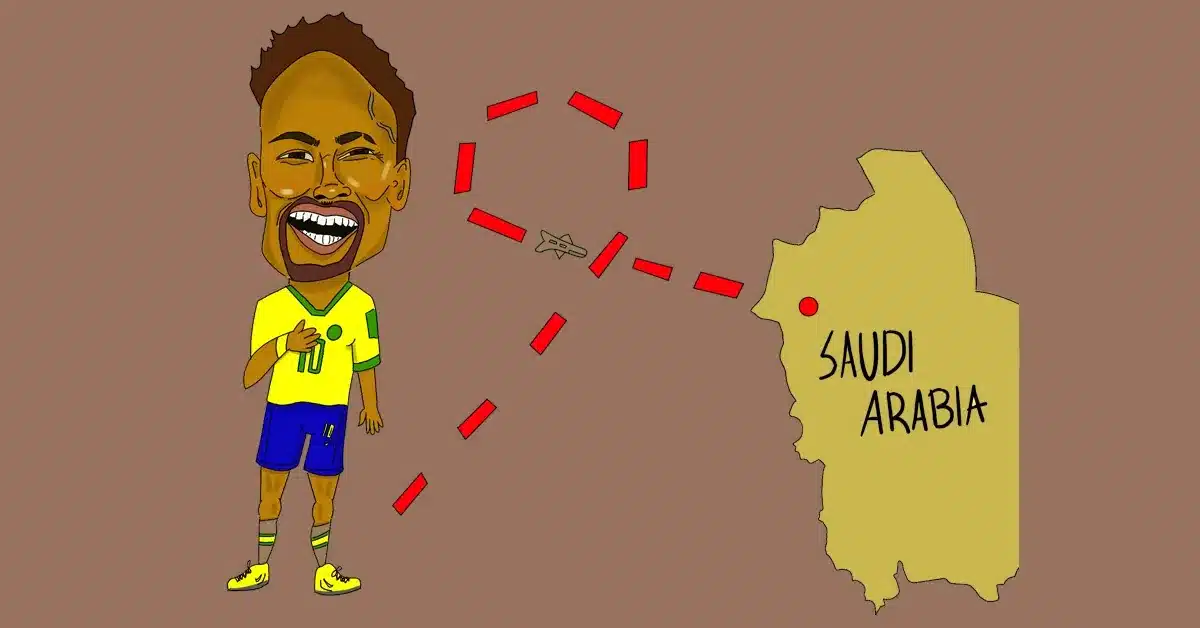Inside Saudi Arabia’s Football Goldrush
The Oil State took the football world by surprise after spending the summer transfer window gobbling up some of the biggest names in the game. Their aim was to increase viewership to their own league, but critics suspect more sinister reasons.
On August 19, the Riyadh-based club Al Hilal unveiled their new marquee signing inside their packed home stadium. Brazilian megastar Neymar Jr. was seen walking onto the pitch in the club’s royal blue kit. Fireworks set off, smoke machines fogged up the pitch, and 65,000 fans sang his name. Above the stadium were drones lit up like stars, tracing out the words “Neymar is blue.”
After spending nearly $1B in the summer transfer market, The Saudi Professional League kicked off its new season on August 11 with the arrival of some of the most prominent players and coaches in the football world. Cristiano Ronaldo set the stage for many of his peers back in January 2023, when his contract was terminated at Manchester United after having a falling out with his coach. The player subsequently joined Riyadh-based club Al-Nassr for a mouth-watering $400 million contract for two years.
Soon after, the Saudi government targeted many big-name footballers nearing their retirement by offering them huge amounts of (untaxed) wages that they simply couldn’t turn down. Many high-profile players such as Real Madrid’s Karim Benzema ($214M), Liverpool’s Jordan Hendersen ($150M), and Bayern Munich’s Sadio Mané (170M) flocked to the Gulf state to receive their last big paycheck. The Saudi League also managed to attract some sought-after players still in their prime like 26-year-old Portuguese midfielder Ruben Neves, who was linked to Barcelona FC but instead joined Al Hilal to earn $300,000 a week—money even Europe’s richest clubs could not afford.
Saudi’s massive spending spree in the football market not only marks a new era for the Saudi Professional League, but also marks the country’s utopian vision for its people. This moment is the first step of their “2030 vision,” an elaborate plan to diversify their economy through sports & tourism and wean off their dependency on oil exportation by 2030. Crown Prince Mohammed bin Salman spearheaded the Saudi Public Investment Fund (PIF) project to inject oil money straight into their underdeveloped football league, where clubs were struggling to pay their players: and not just football, but other universally watched sports, such as boxing, Formula 1, and the LIV golf tour.
Another reason why sports is a big priority in the country is because 67 per cent of the country’s population is under 35, a young demographic that creates huge demand for sports and entertainment. Having the biggest football stars playing within Saudi borders can generate massive amounts of revenue for the state. Additionally, as part of the Vision 2030, the Saudi government aims to host the FIFA World Cup after seeing how people from all corners of the world came to attend the prestigious sporting event when it was held in neighboring Qatar.
Critics have accused the Saudi regime of “Sportswashing,” a process in which the government tries to fix its reputation by investing in its sports & entertainment industry. Although the country has been slowly reforming its ultra-conservative policies, Saudi continues to draw negative international attention with ongoing injustices, such as the imprisonment of journalists, public executions, and the massacring of migrants. The Saudi government hopes to dominate international headlines by hosting top athletes and sporting events, earning a more favourable view from the rest of the world.
The Kingdom of Saudi Arabia is taking a massive gamble on its future. It’s too early to tell whether their reckless spending will result in them becoming the epicenter of live sports or leaving their economy in ruins. In the meantime, make sure to tune into the next Al Nassr game where Ronaldo might score a cool goal!

